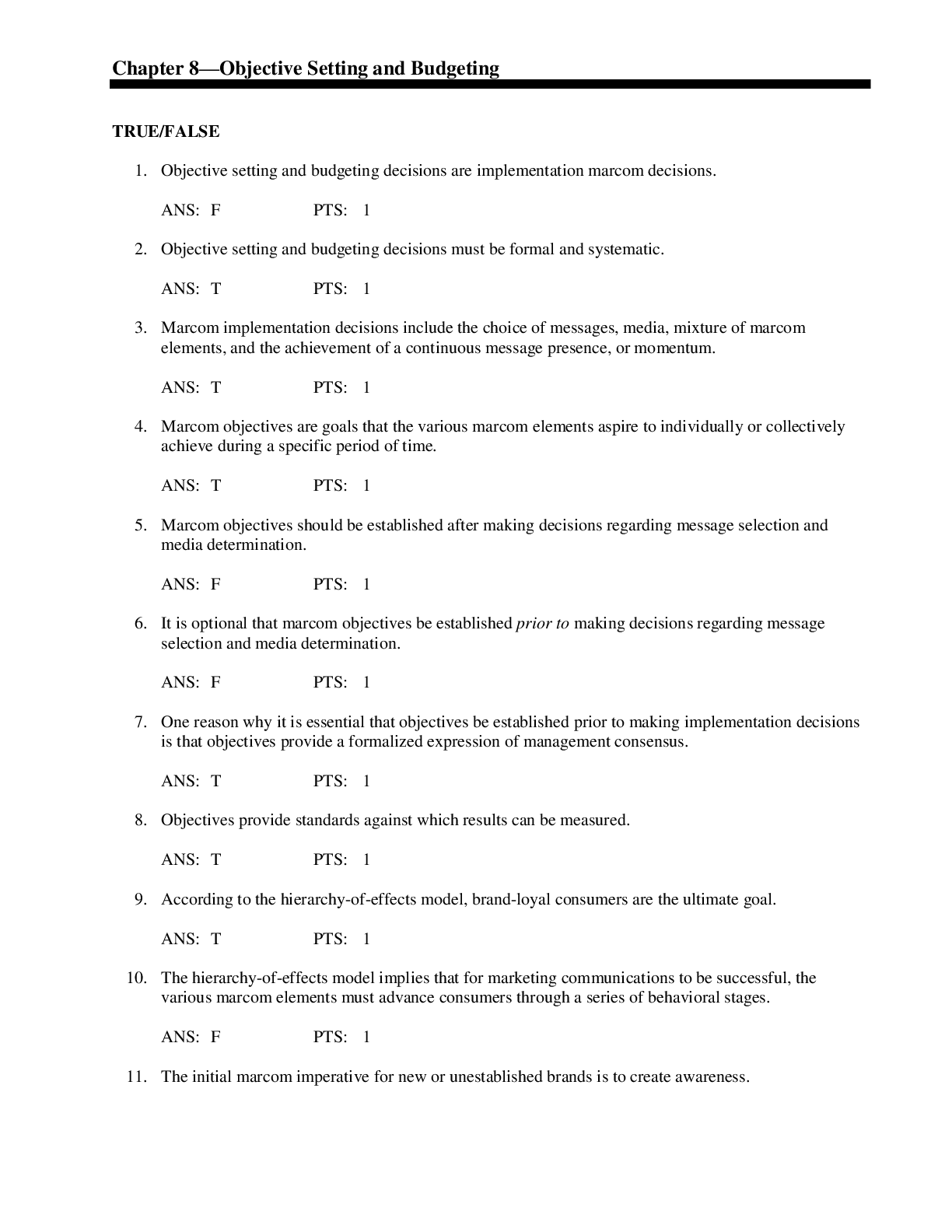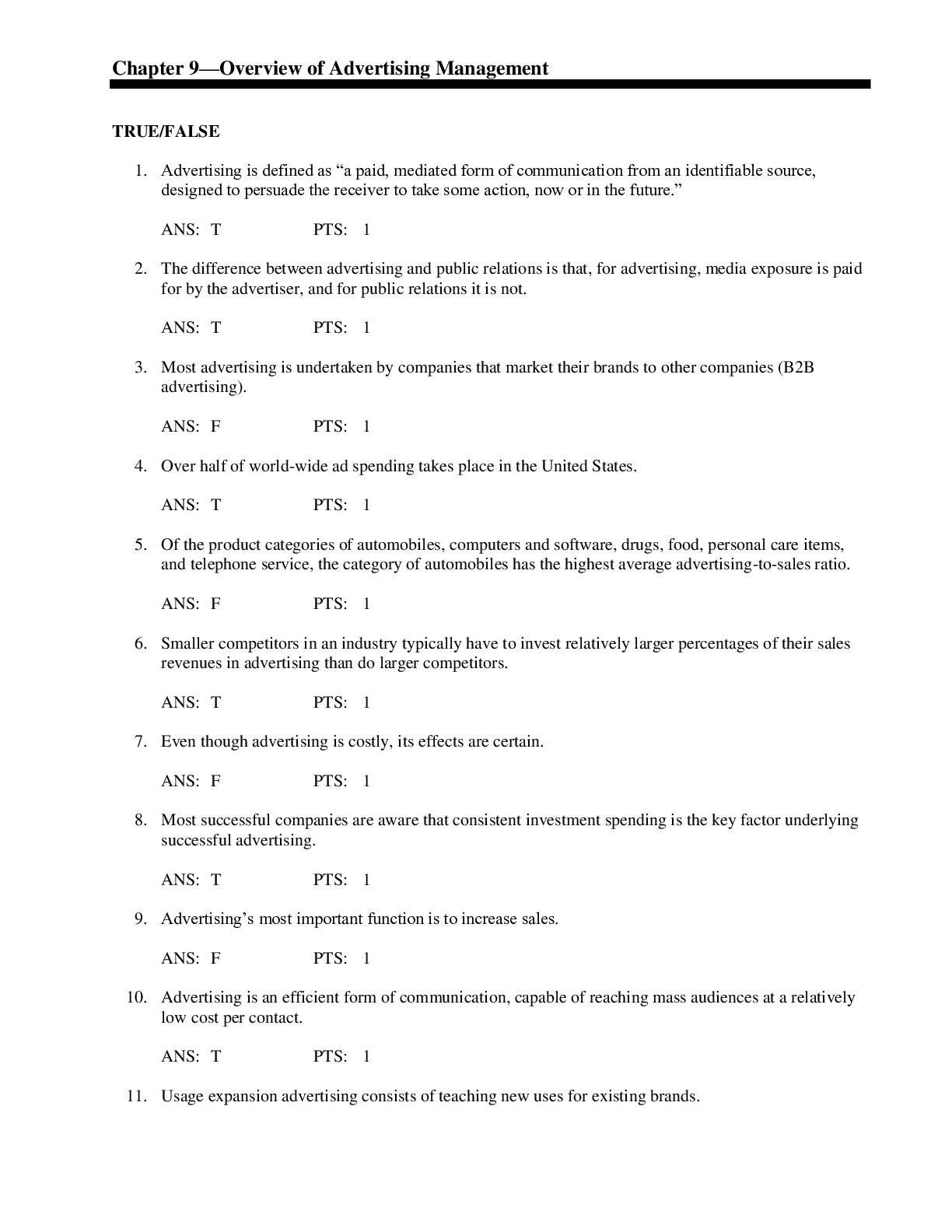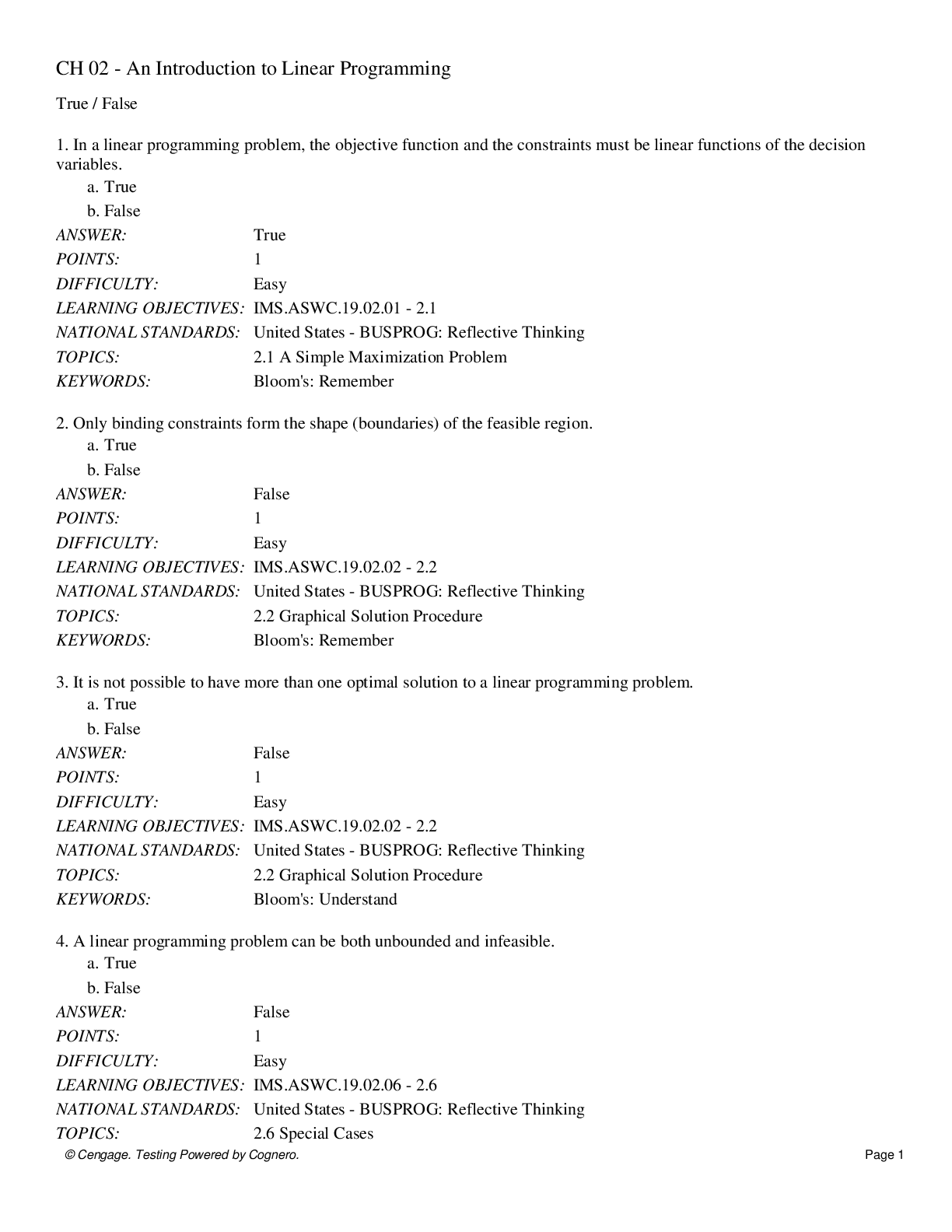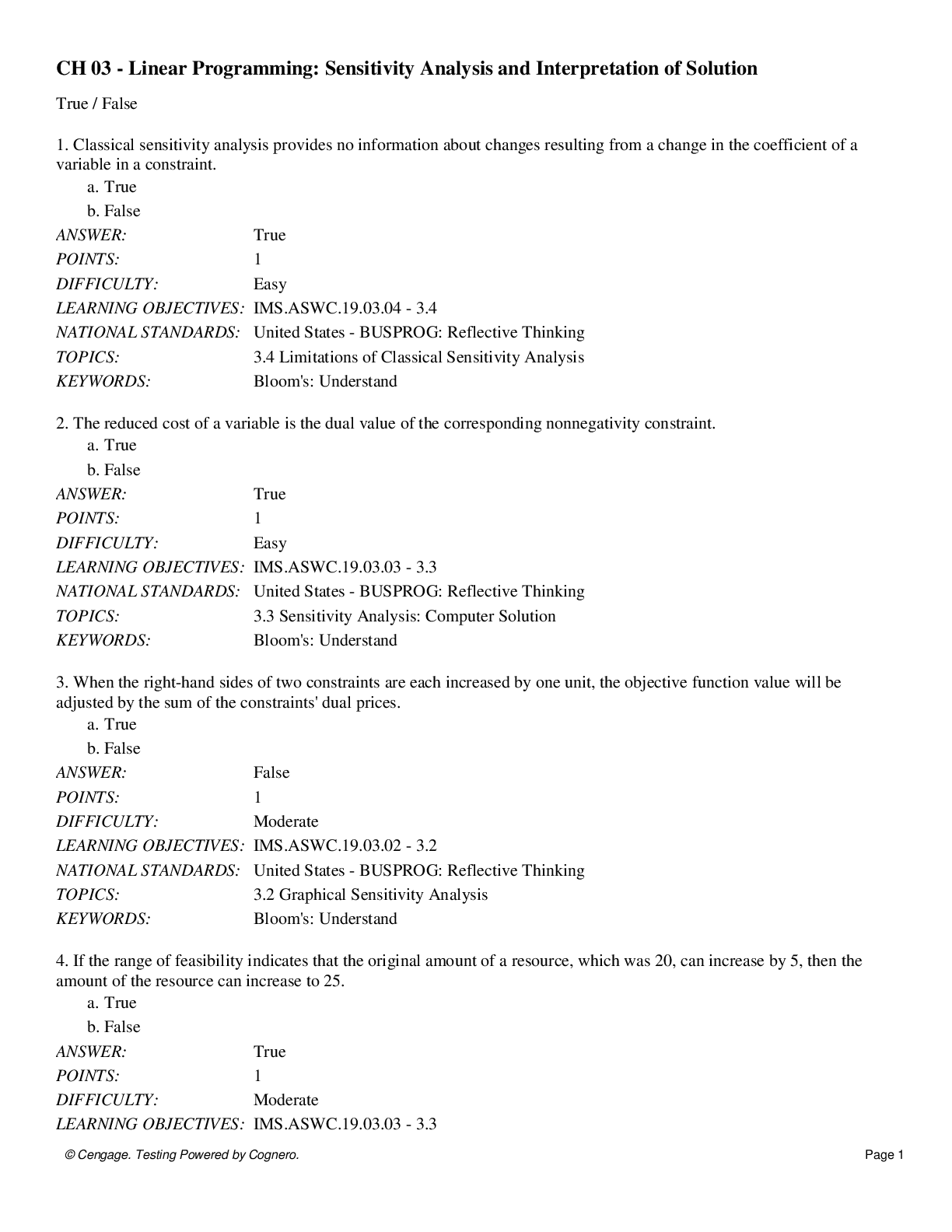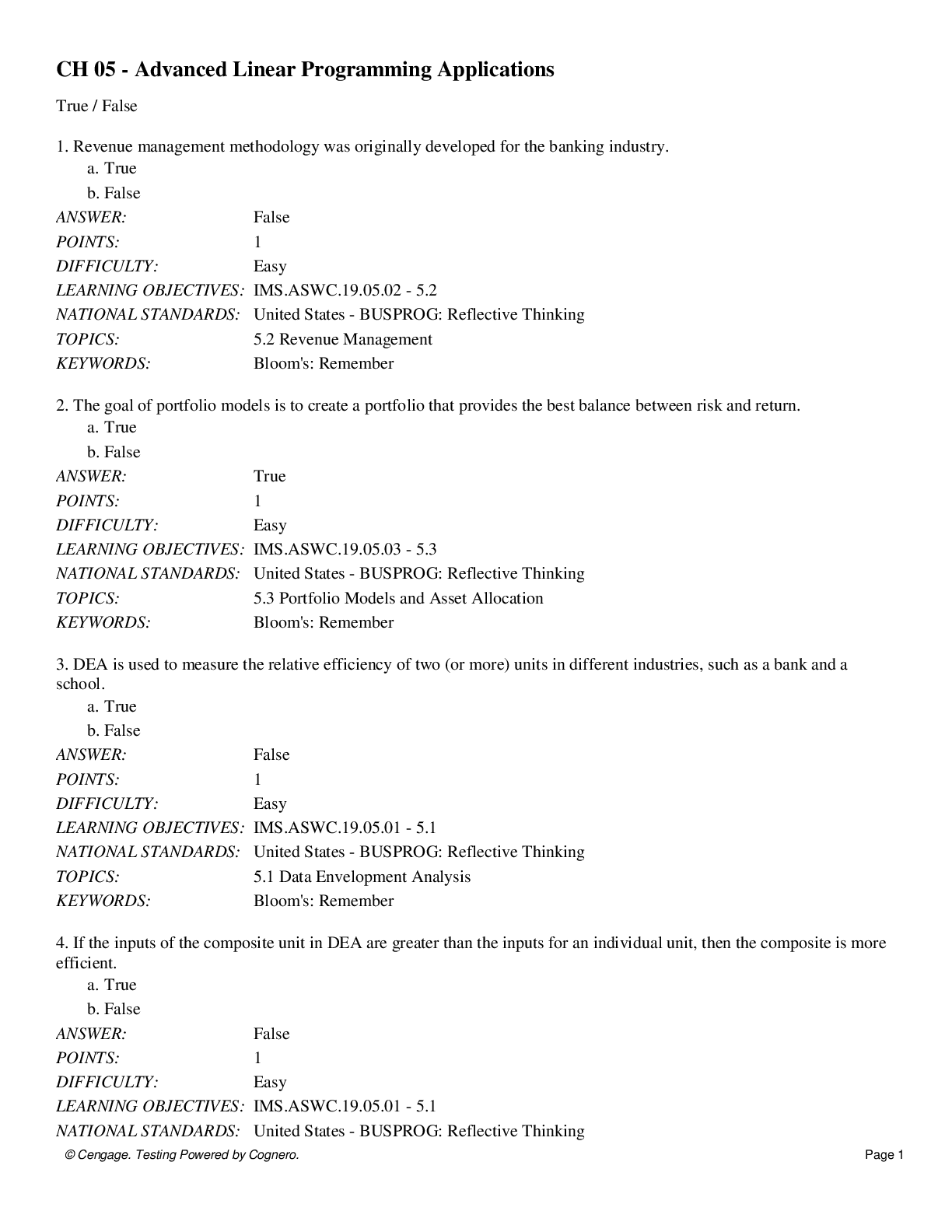*NURSING > QUESTIONS & ANSWERS > NR 511 Week 1 Practice Questions And Answers A+ Guide (Davis Edge) (All)
NR 511 Week 1 Practice Questions And Answers A+ Guide (Davis Edge)
Document Content and Description Below
Week 1 practice questions 1. Which of the following initiatives does not fall under the National Prevention Strategy? Diabetes Management. Reference Page 29 Tobacco Free Living Healthy... Eating Mental and Emotional Wellbeing 2. All of the following statements about the US Preventive Services Task Force (USPSTF) are true except? All of the recommendations made by the USPSTF are strong recommendations. (The recommendations made by this organization are based on a grading scale. Some of the guidelines state that they don’t have enough scientific data to support an informed recommendation.) Reference Page 31-32 This is a private sector group without government ties. This group makes recommendations about preventive medicine. All of the USPSTF recommendations are considered mandatory in primary care. 3. What type of reaction following an immunization is considered serious and requires reevaluation? Temperature greater than 103˚F. (High fever is a reason to reevaluate a patient following a vaccine. Reference Page 33 Fatigue Temperature of 100.2˚F. Erythema and soreness at the injection site. 4. Herbert, a 69-year-old man, comes to your office complaining of nocturia. On questioning Herbert, you find that for the past 3 months he has been getting up at least 5 times a night to void. He came in to seek help today because of his wife’s insistence that he be checked out. When you perform the digital rectal exam, you find that his prostate protrudes 3 to 4 cm into the rectum. What grade would you assign to Herbert’s prostate enlargement? Grade 1 (Grade 1 enlargement is a protrusion of 1 to 2 cm.) Grade 2 (Grade 2 enlargement is a protrusion of 2 to 3 cm) Grade 3 (The degree of prostate enlargement is based on the amount of projection of the prostate into the rectum. The normal prostate protrudes less than 1 cm into the rectum. A grade 3 enlargement is 3 to 4 cm. into the rectum) Reference Page 748 Grade 4 (Grade 4 enlargement is a protrusion of greater than 4 cm) 5. Which of the following individuals should get the shingles (herpes zoster) vaccine? Jerry, who has a mild upper respiratory tract infection and is allergic to neomycin (Allergy to neomycin is a contraindication to receiving the shingles vaccine) Tim, who has been on prolonged use of high-dose steroids for his chronic obstructive pulmonary disease (COPD). (Prolonged use of high-dose steroids is a contraindication to receiving the shingles vaccine) Joan, whose husband recently had shingles and who is trying to get pregnant (Women should not get pregnant until 4 weeks after receiving the vaccination) Joe, who has a stressful job (Joe, who has a stressful job, is a candidate for the shingles (herpes zoster) vaccine) Reference page 134 6. As a primary care provider, which of the following topics is not typically important for adults aged 20 to 40? Focusing on increasing lifespan. (This is typically important to patients greater than 65 years old) Career development. Self-image. Family relationships. 7. Which of the following statements defines health literacy? The level to which a patient can understand, gain access to, and make proper medical decisions. The ability of a patient to read health pamphlets. The extent to which a patient can travel to see a medical provider. The ability of a patient to write in the language of the health practitioner. 8. Between ages 7 and 18, both boys and girls are immunized against the following diseases: Tetanus, diphtheria, pertussis, meningitis, and human papillomavirus. Tetanus, diphtheria, pertussis, and rotavirus. (The rotavirus vaccine is given prior to age 7) Tetanus, diphtheria, pertussis, meningitis, human papillomavirus, and hepatitis A. (The hepatitis A vaccine is given prior to age 7) 1 Tetanus, diphtheria, pertussis, meningitis, human papillomavirus, and hepatitis C. (There is no known vaccine for Hep C yet) 9. The OLD CARTS (onset, location, duration, character, aggravating/alleviating factors, radiation, timing, severity) mnemonic is best used in which part of your chart note? History of present illness (The OLD CARTS mnemonic is best used to describe the patient’s symptoms in the history of present illness) Plan. Diagnosis. Physical exam. 10. Eileen, a 42-year-old woman, comes to your office with a chief complaint of fatigue, weight loss, and blurred vision. Eileen has a past medical history that is negative for any chronic medical problems. You obtain a fasting chemistry panel, lipid profile, complete blood count (CBC), and hemoglobin A1c (HbA1c). The results of the blood work show Eileen’s blood sugar elevated at 356 mg/dL, total cholesterol elevated at 255, high-density lipoprotein (HDL) cholesterol low at 28, low-density lipoprotein (LDL) cholesterol elevated at 167, triglycerides 333, and HbA1c 12. On questioning Eileen further, you discover that both her grandmothers had adult-onset diabetes mellitus. You diagnose type 2 diabetes mellitus. Your treatment plan should include a cholesterol-lowering agent, an agent that lowers blood sugar, and which other class of medication? Angiotensin-converting enzyme (ACE) inhibitor ( Studies have shown the use of ACE inhibitors in clients with diabetes, with or without hypertension, has slowed the progression of nephropathy. You must monitor the client’s creatinine and potassium levels routinely. If the client’s renal function does decrease, elevated potassium levels may occur. Some clinicians disagree on this approach and recommend waiting until microalbuminuria is present before initiating an ACE inhibitor. Other clinicians feel that her A1C indicates that she has been a diabetic for probably 10 years and would benefit from this approach) Diuretic. Weight loss medication (Diet and weight loss are fundamental components of diabetes management) Beta blocker. 11. Margaret, age 29, is of medium build and 5 ft 4 in tall. You estimate that she should weigh about: 105 lb. 110 lb. 120 lb (To estimate a client’s ideal weight, use the following formula: For women older than age 25, allow 100 lb for the first 5 ft, then add 5 lb for each inch thereafter. For men, allow 106 lb for the first 5 ft, then add 6 lb for each inch thereafter. Multiply the number by 110% for a client with a large frame and 90% for a client with a small frame) 130 lb. 12. Susie, age 5, comes to the clinic for a well-child visit. She has not been in since she was 2. Her immunizations are up to date. What immunizations would you give her today? None; wait until she is 6 years old to give her her booster shots (Susie is due for diphtheria, tetanus, and pertussis (DTaP); inactivated polio vaccine (IPV); and measles, mumps, and rubella (MMR) between the ages of 4 and 6. There is no need to wait until she is 6 years old) Diphtheria, tetanus, and pertussis (DTaP); Haemophilus influenzae type B (Hib); and measles, mumps, and rubella (MMR) ( Susie is due for inactivated polio vaccine (IPV), in addition to DTaP and MMR. She is not due for Hib) Diphtheria, tetanus, and pertussis (DTaP) and inactivated polio vaccine (IPV) (Susie is due for measles, mumps, and rubella (MMR), in addition to DTaP and IPV) Diphtheria, tetanus, and pertussis (DTaP); inactivated polio vaccine (IPV); and measles, mumps, and rubella (MMR) (Because Susie has not been in for several years, one cannot assume she will come in next year to get the immunizations that are due between the ages of 4 and 6; therefore, this opportunity to give her needed immunizations cannot be missed. Between the ages of 4 and 6, a child is due for DTaP, IPV, and MMR, if all other immunizations are up to date) 13. Mimi, age 52, asks why she should perform a monthly breast self-examination (BSE) when she has her mammograms on schedule. You respond: “If you are faithful about your annual exams and mammograms, that is enough.” (All women older than age 20 should examine their breasts monthly) 2 “More breast abnormalities are picked up by mammograms than by clinical exams or BSE.” ( More than 90% of all breast abnormalities are first detected by self-examination_ “More than 90% of all breast abnormalities are first detected by self-examination.” (More than 90% of all breast abnormalities are first detected by self-examination. All women older than age 20 should examine their breasts monthly, a week after their period. After menopause, women should examine their breasts at the same time each month. There is some controversy. Most women perform BSE incorrectly, thus making the significance of a positive finding questionable. Breastcancer.org recommends a BSE be performed as a mammogram may miss a tumor) “Self-examinations need to be performed only every other month.” ( All women older than age 20 should examine their breasts monthly) 14. Marian’s husband, Stu, age 72, has temporal arteritis. She tells you that his physician wants to perform a biopsy of the temporal artery. She asks if there is a less invasive diagnostic test. What test do you tell her is less invasive? Computed tomography (CT) scan (A CT scan and magnetic resonance imaging (MRI) are done to detect neurological damage from hemorrhage, tumor, cyst, edema, or myocardial infarction. These tests may also identify displacement of the brain structures by expanding lesions. However, not all lesions can be detected by CT scan or MRI) [Show More]
Last updated: 1 year ago
Preview 1 out of 21 pages

Buy this document to get the full access instantly
Instant Download Access after purchase
Add to cartInstant download
We Accept:

Reviews( 0 )
$15.00
Document information
Connected school, study & course
About the document
Uploaded On
Jul 14, 2021
Number of pages
21
Written in
Additional information
This document has been written for:
Uploaded
Jul 14, 2021
Downloads
0
Views
31

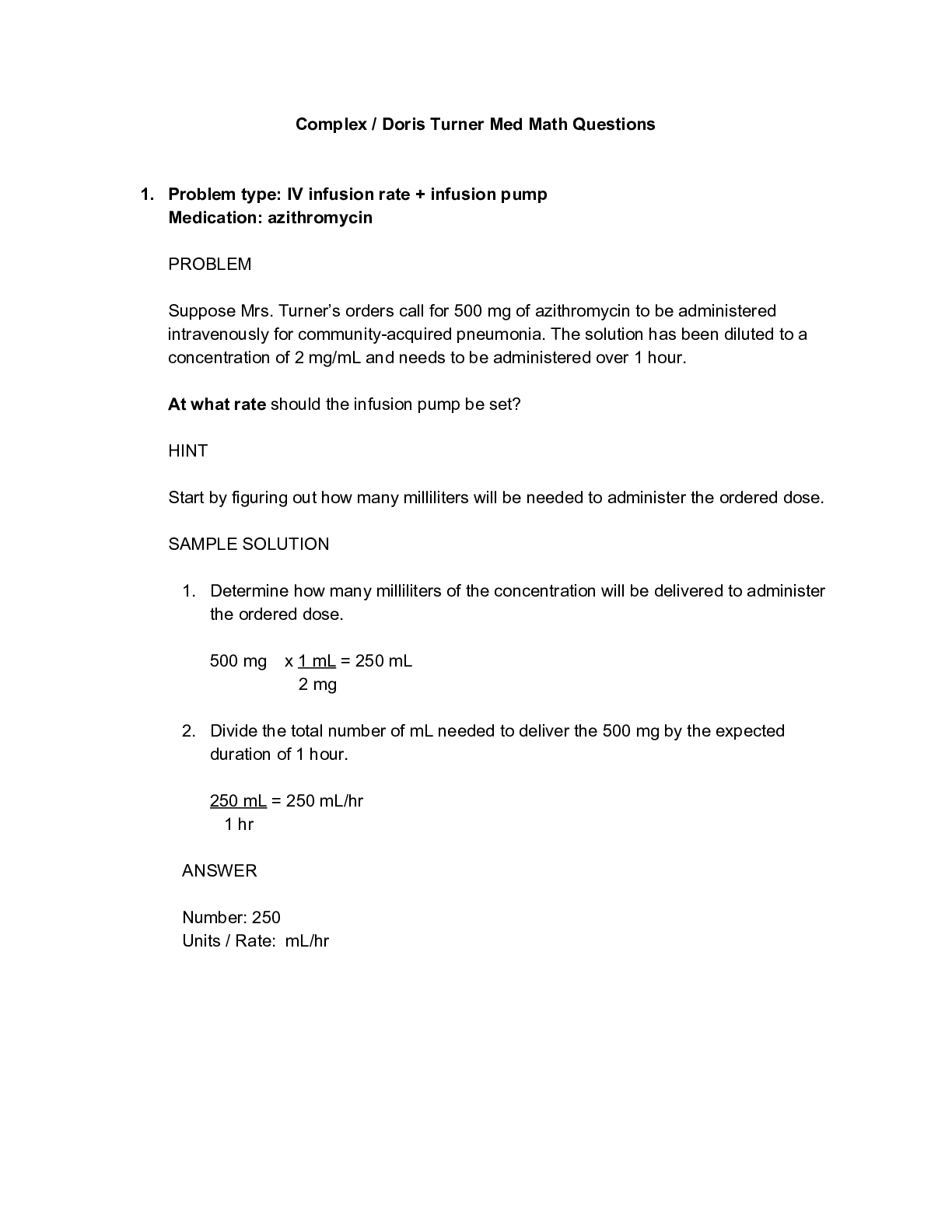





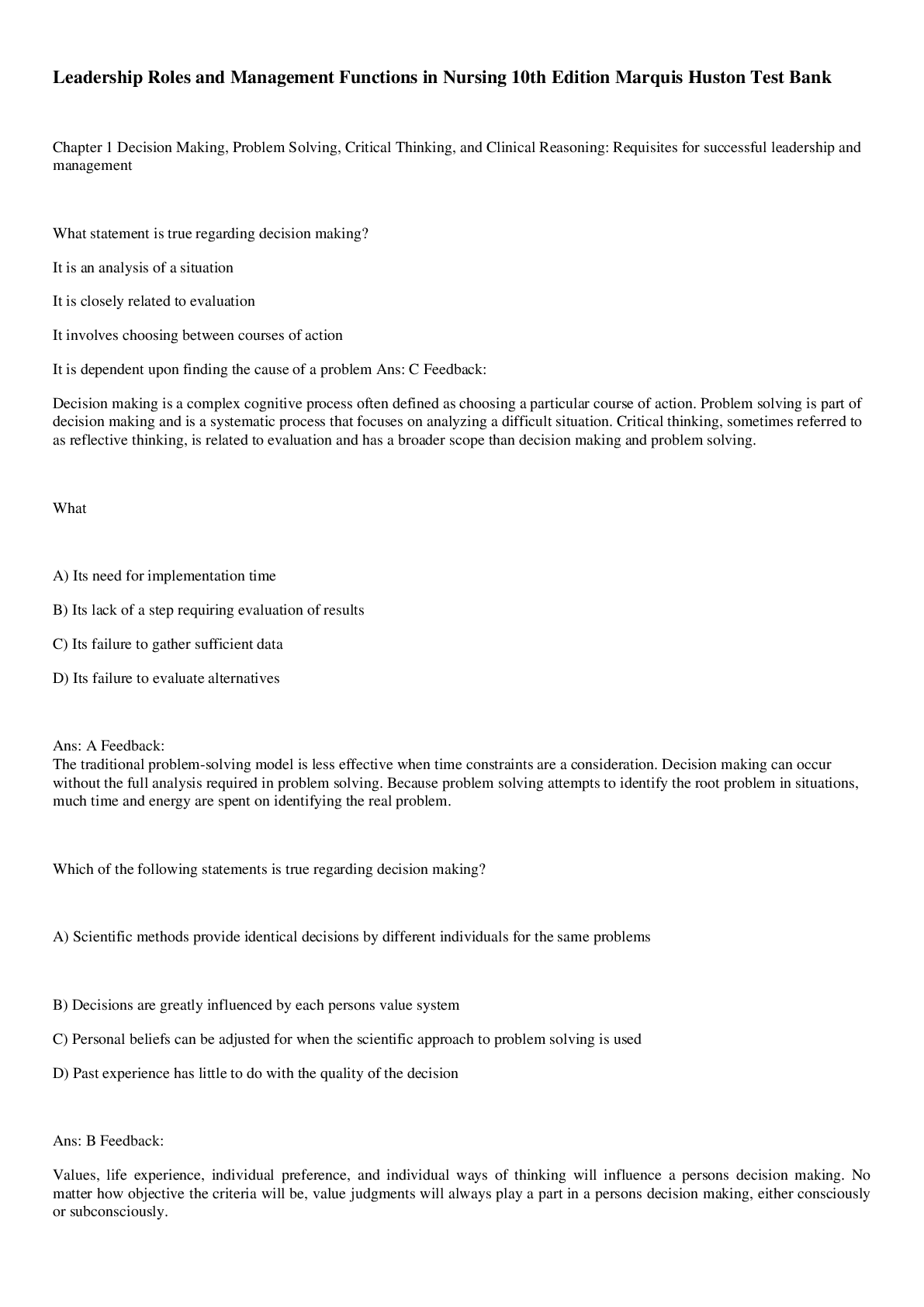


 (1).png)






